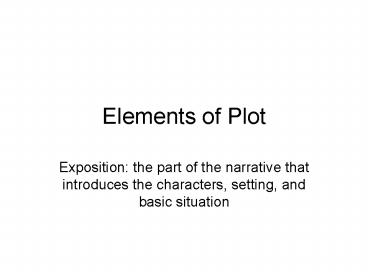Elements of Plot - PowerPoint PPT Presentation
1 / 22
Title:
Elements of Plot
Description:
Man v himself: a mental, moral emotional, or other psychological struggle. ... Denouement: any events in the narrative that come after the resolution. ... – PowerPoint PPT presentation
Number of Views:62
Avg rating:3.0/5.0
Title: Elements of Plot
1
Elements of Plot
- Exposition the part of the narrative that
introduces the characters, setting, and basic
situation
2
- Inciting incident the part of the narrative
that introduces the conflict
3
- Conflict
- Rising action
- Complication
- Development a struggle between opposing forces
4
6 Major Types of Conflict
- Man v himself a mental, moral emotional, or
other psychological struggle. - Man v man a struggle between one or more people
against one or more other people. - Man v Machine a struggle against something
created by a human or other intelligent life
beside God.
5
- Man v nature a struggle against animals or
other natural object. - Man v supernatural a struggle against angels,
demons the devil, God, or gods.
6
- Climax (Crisis or Turning Point) the high point
of interest, emotional intensity, or suspense in
a narrative, which determines how the conflict
will turn out.
7
- Falling Action
8
- Resolution following the climax, this of the
narrative is the final outcome of the conflict.
9
- Denouement any events in the narrative that
come after the resolution.
10
- Sub Plot a second, less important plot within a
narrative.
11
- Resolution following the climax, this part of
the narrative is the final outcome of the
conflict.
12
- Flashback
13
- Foreshadowing
14
- Characterization the act of creating or
developing a character within a literary work. - Direct Characterization
- Indirect Charaterization
15
Types of character
- Protagonist (Main Character) The character most
involved in the narrative.
16
- Antagonist the character or force in conflict
with the protagonist.
17
- Subordinate character the characters who have
only a small part in the narrative.
18
- Narrator a character, though not necessarily in
the narrative, who tells the narrative. - Unreliable Narrator
19
Types of character development
- Flat character has only one or two
characteristics.
20
- Round character is complicated and exhibits
numerous qualities and traits.
21
- Static character stays the same throughout the
narrative.
22
- Dynamic character is changed through the events
and interaction with other characters of the
narrative.































